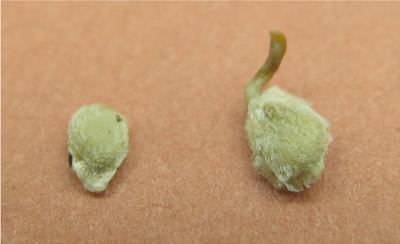Carbon nanotubes: Great for agriculture, but for humans?

In what can eventually kick up a firestorm similar to the genetically modified food controversy, the emerging field of "nano-agriculture" is making headlines. It involves the use of nano-particles — wisps 1/50,000th the width of a human hair — in agriculture and could have beneficial affects for crops, say scientists.

Tomato seeds exposed to carbon nanotubes (right) sprouted and grew faster than unexposed seeds. (Credit: The American Chemical Society)
University of Arkansas researchers report that tomato seeds exposed to carbon nanotubes (CNTs) germinated faster and grew into larger, heavier seedlings than other seeds. That growth-enhancing effect could be a boon for biomass production for plant-based biofuels and other agricultural products, they suggest.
Considerable scientific research is underway to use nanoparticles — wisps 1/50,000th the width of a human hair — in agriculture. The goals of "nano-agriculture" include improving the productivity of plants for food, fuel, and other uses.
The scientists report the first evidence that CNTs penetrate the thick outer coating of seeds, and support water uptake inside seeds, a process which can affect seed germination and growth of tomato seedlings.The nanotube-exposed seeds sprouted up to two times faster than control seeds and the seedlings weighed more than twice as much as the untreated plants.
"This observed positive effect of CNTs on the seed germination could have significant economic importance for agriculture, horticulture, and the energy sector, such as for production of biofuels," they add.
The study, conducted by Mariya Khodakovskaya, Alexandru Biris, and other colleagues at the Department of Applied Science, is scheduled for the October issue of ACS Nano.
The research begs the question of the impact CNT-treated crops would have on humans and animals that consume them. It was outside the scope of the Arkansas study, and little is known whether these materials cause health problems.
But a recent joint study from North Carolina State University, The Hamner Institutes for Health Sciences, and the National Institute of Environmental Health Sciences shows evidence that they do, at least when inhaled.
Using lab mice, researchers found that inhaling nanotubes can affect the outer lining of the lung, though the effects of long-term exposure remain unclear. They determined that when multi-walled carbon nanotubes are inhaled they reach the pleura, which is the tissue that lines the outside of the lungs and is affected by exposure to certain types of asbestos fibers which cause the cancer mesothelioma.
The inhaled nanotubes "clearly reach the target tissue for mesothelioma and cause a unique pathologic reaction on the surface of the pleura, and caused fibrosis," says Dr. James Bonner, associate professor of environmental and molecular toxicology at NC State and senior author of the study.
The study used a single exposure to the nanotubes and revealed that the immune response and fibrosis disappeared within three months of exposure.
"It remains unclear whether the pleura could recover from chronic, or repeated, exposures," Bonner says. "More work needs to be done in that area and it is completely unknown at this point whether inhaled carbon nanotubes will prove to be carcinogenic in the lungs or in the pleural lining."
While they are at it, hopefully other nanotech researchers are on the task of figuring out the health implications of CNTs coming through the digestive system.